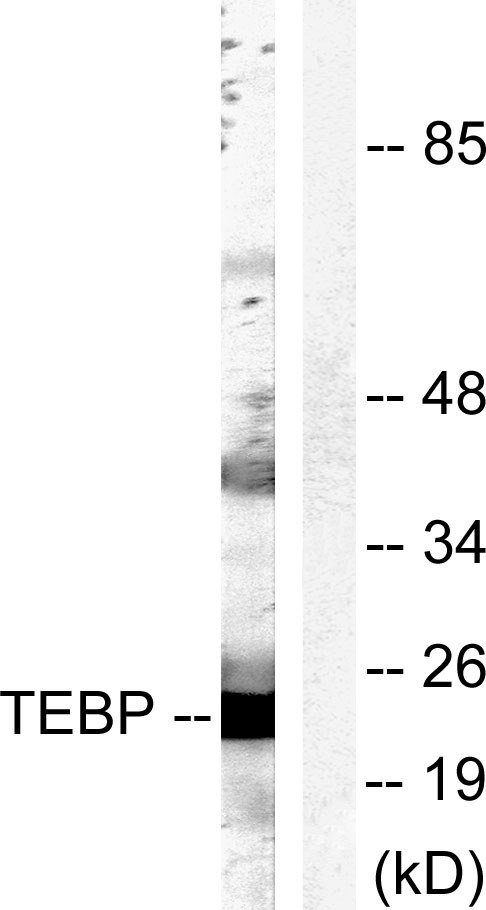p23 Polyclonal Antibody
- Catalog No.:YT3498
- Applications:WB;IHC;IF;ELISA
- Reactivity:Human;Mouse;Rat
- Target:
- p23
- Fields:
- >>Arachidonic acid metabolism;>>Metabolic pathways;>>Chemical carcinogenesis - receptor activation
- Gene Name:
- PTGES3
- Protein Name:
- Prostaglandin E synthase 3
- Human Gene Id:
- 10728
- Human Swiss Prot No:
- Q15185
- Mouse Gene Id:
- 1.00044e+008
- Mouse Swiss Prot No:
- Q9R0Q7
- Rat Gene Id:
- 362809
- Rat Swiss Prot No:
- P83868
- Immunogen:
- The antiserum was produced against synthesized peptide derived from human TEBP. AA range:79-128
- Specificity:
- p23 Polyclonal Antibody detects endogenous levels of p23 protein.
- Formulation:
- Liquid in PBS containing 50% glycerol, 0.5% BSA and 0.02% sodium azide.
- Source:
- Polyclonal, Rabbit,IgG
- Dilution:
- WB 1:500 - 1:2000. IHC 1:100 - 1:300. ELISA: 1:10000.. IF 1:50-200
- Purification:
- The antibody was affinity-purified from rabbit antiserum by affinity-chromatography using epitope-specific immunogen.
- Concentration:
- 1 mg/ml
- Storage Stability:
- -15°C to -25°C/1 year(Do not lower than -25°C)
- Other Name:
- PTGES3;P23;TEBP;Prostaglandin E synthase 3;Cytosolic prostaglandin E2 synthase;cPGES;Hsp90 co-chaperone;Progesterone receptor complex p23;Telomerase-binding protein p23
- Observed Band(KD):
- 24kD
- Background:
- This gene encodes an enzyme that converts prostaglandin endoperoxide H2 (PGH2) to prostaglandin E2 (PGE2). This protein functions as a co-chaperone with heat shock protein 90 (HSP90), localizing to response elements in DNA and disrupting transcriptional activation complexes. Alternative splicing results in multiple transcript variants. There are multiple pseudogenes of this gene on several different chromosomes. [provided by RefSeq, Feb 2016],
- Function:
- catalytic activity:(5Z,13E)-(15S)-9-alpha,11-alpha-epidioxy-15-hydroxyprosta-5,13-dienoate = (5Z,13E)-(15S)-11-alpha,15-dihydroxy-9-oxoprosta-5,13-dienoate.,function:Molecular chaperone that localizes to genomic response elements in a hormone-dependent manner and disrupts receptor-mediated transcriptional activation, by promoting disassembly of transcriptional regulatory complexes.,pathway:Lipid metabolism; prostaglandin biosynthesis.,similarity:Belongs to the p23/wos2 family.,similarity:Contains 1 CS domain.,subunit:Binds to telomerase and to the progesterone receptor.,
- Subcellular Location:
- Cytoplasm .
- Expression:
- Embryonic kidney,Epithelium,Liver,Lung,Pituitary,Platelet,T-cell,Testis,Uri
- June 19-2018
- WESTERN IMMUNOBLOTTING PROTOCOL
- June 19-2018
- IMMUNOHISTOCHEMISTRY-PARAFFIN PROTOCOL
- June 19-2018
- IMMUNOFLUORESCENCE PROTOCOL
- September 08-2020
- FLOW-CYTOMEYRT-PROTOCOL
- May 20-2022
- Cell-Based ELISA│解您多样本WB检测之困扰
- July 13-2018
- CELL-BASED-ELISA-PROTOCOL-FOR-ACETYL-PROTEIN
- July 13-2018
- CELL-BASED-ELISA-PROTOCOL-FOR-PHOSPHO-PROTEIN
- July 13-2018
- Antibody-FAQs
- Products Images

- Western Blot analysis of various cells using p23 Polyclonal Antibody diluted at 1:2000
.jpg)
- Western Blot analysis of K562 cells using p23 Polyclonal Antibody diluted at 1:2000

- Immunohistochemistry analysis of paraffin-embedded human breast carcinoma tissue, using TEBP Antibody. The picture on the right is blocked with the synthesized peptide.

- Western blot analysis of lysates from NIH/3T3 cells, treated with EGF 200ng/ml 30', using TEBP Antibody. The lane on the right is blocked with the synthesized peptide.



